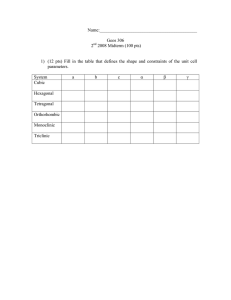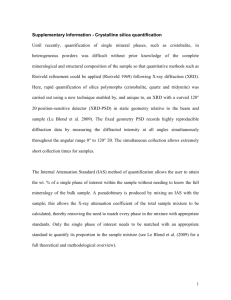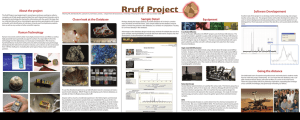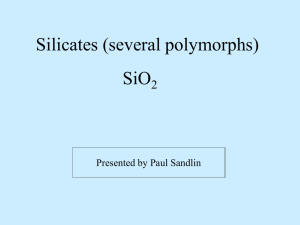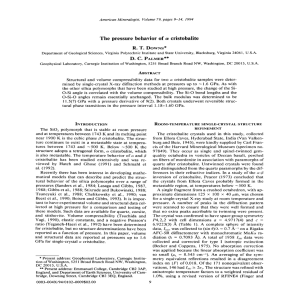THE HIGH PRESSURE BEHAVIOR OF CRISTOBALITE C
advertisement
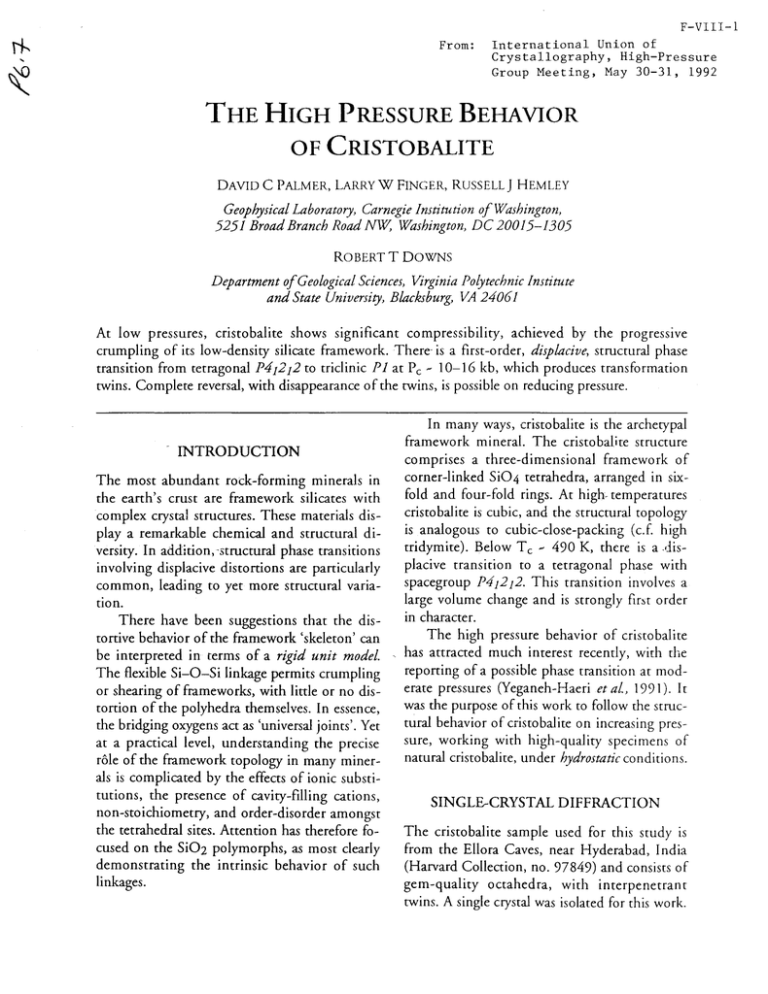
F-VIII-1 From: International Union of Crystallography, High-Pressure Group Meeting, May 30-31, 1992 THE HIGH PRESSURE BEHAVIOR OF CRISTOBALITE DAVID C PALMER, LARRYW FINGER, RUSSELL] HEMLEY Geophysical Laboratory, Carnegie Institution of Washington, 5251 Broad Branch Road NW, Washington, DC 20015-1305 ROBERTT DOWNS Department of Geological Sciences, Virginia Polytechnic Institute and State University, Blacksburg, VA 24061 At low pressures, crisrobalite shows significant compressibility, achieved by the progressive crumpling of its low-density silicate framework. There~ is a first-order, displacive, structural phase transition from tetragonal P4j2j2 to triclinic PI at Pc 10-16 kb, which produces transformation twins. Complete reversal, with disappearance of the twins, is possible on reducing pressure. - ~ INTRODUCTION The most abundant rock-forming minerals in the eanh's crust are framework silicates with complex crystal structures. These materials displaya remarkable chemical and structUral diversity. In addition,~structUral phase transitions involving displacive distonions are panicularly common, leading to yet more structural variation. There have been suggestions that the distonive behavior of the framework 'skeleton' can be interpreted in terms of a rigid unit model. The flexible Si-O-Si linkage permits crumpling or shearing of frameworks, with little or no distonion of the polyhedra themselves. In essence, the bridging oxygens act as 'universal joints' . Yet at a practical level, understanding the precise role of the framework topology in many minerals is complicated by the effects of ionic substitUtions, the presence of cavity-filling cations, non-stoichiometry, and order-disorder amongst the tetrahedral sites. Attention has therefore focused on the Si02 polymorphs, as most clearly demonstrating the intrinsic behavior of such linkages. In many ways, cristobalite is the archetypal framework mineral. The cristobalite structure comprises a three-dimensional framework of corner-linked Si04 tetrahedra, arranged in sixfold and four-fold rings. At high. temperatures cristobalite is cubic, and the structural topology is analogous to cubic-close-packing (c.f. high tridymite). Below T c - 490 K, there is a .displacive transition to a tetragonal phase with spacegroup P4]2]2. This transition involves a large volume change and is strongly first order in character. The high pressure behavior of cristobalite has attracted much interest recently, with the reponing of a possible phase transition at moderate pressures (Yeganeh-Haeri etaL, 1991). It was the purpose of this work to follow the structUral behavior of cristo bal ite on increasing pressure, working with high-quality specimens of natUral cristobalite, under hydrostatic conditions. SINGLE-CRYSTAL DIFFRACTION The cristobalite sample used for this study is from the Ellora Caves, near Hyderabad, India (Harvard Collection, no. 97849) and consists of gem-quality octahedra, with interpenetranr twins. A single crystal was isolated for this work. F-Vill-2 Table 1: StructUral parameters for tetragonal cristObalite y(O) z(O) B(O) x(O) 0.1044(2) 1.48(3) 0.1787(1) 0.2392(2) 1.26(8) 0.1084(6) 0.1815(4) 0.2383(8) 1.07(9) 0.2364(10) 0.1197(11) 0.1871(6) 1.20(13) 0.1265(11) 0.1905(8) 0.2351(11) tained by a slight crumpling of the tetrahedral A 1 atm X-ray structure refinement was carried framework, changing Si-O-Si, with little, if out to verify that the crystal was completely any, distortion of the tetrahedra, measured by untwinned. The crystal was then mounted in a the two Si-O distances, Rl and R2. Merrill-Bassett diamond-anvil cell using a 4: 1 Above 10-15 kbar, the crystal transformed methanol/ethanol mixture as pressure medium. Cell parameters were determined using 10 to 20 to a new, non-tetragonal, phase, characterized by transformation twinning. Reflexion profiles reflexions with 30° ~ 28 ~ 40°, centered at eight were collected using 8/28 and w scans across the equivalent positions, following the procedure of positions of the former tetragonal 011 and 101 King and Finger (1979). Initial unit-cell refinereflexions. ments were made without constraints, to test for The phase transition is completely reversible noe-tetragonal distOrtions, although none were found. The cell parameters were then deterand appears to be displacive in character. On decreasing pressure, the twins vanish and the mined by the vector least-squares method with tetragonal constraints (Ralph and Finger 1982). former orientation of the tetragonal cell reapFull intensity data collections were made at 0.0, pears. Clearly there is a crystallographic rela1.2, 6.9 and 10.1 kbar. A second crystal:. (also tionship between the two phases, i.e., a super_ untwinned) was used for additional cell paramegroup-subgroup relation. By analyzing the possiter measurements. This showed no significant ble subgroups of 422, and the number of twin differences in structural behavior from the first components expected, we predict that the high crystal. pressure phase is triclinic, with spacegroup P1. Pressure calibration was by the ruby fluorescence method, measuring a number of different X-RAY POWDER DIFFRACTION rubies inside the cell, to test for possible pressure gradients. We took great care to ensure a consisA small volume of powdered cristobalite was tent and relatively-accurate pressure calibration. mounted within the sample chamber of a diaRuby R1 and R2 fluorescence peaks were fitted mond-anvil cell, rogether with a number of tiny using least-squares profile refinement, and presrubies, for pressure calibration. A 4: 1 sures calculated using 1 atm standards, and a methanol/ethanol mix was used as pressure tem perature-cor rectio n. medium and the sample was compressed to Cristobalite is a relatively soft mineral, with 30 kb. Ruby fluorescence spectra displayed wella very low value for the isothermal bulk moduresolved Rl & R2 peaks, with no significant 7.0). The mineral lus, KOT 128 kbar (K' broadening, indicating that the mount was subshows anisotropic behavor as a function of presject to hydrostatic pressure. sure, with the c axis more compressible than the Diffraction experiments were carried oUt at a and b axes. The axial compressibilites, calcuthe National Synchrotron Light Source (NSLS), lated from linear regressions of the cell parameBrookhaven National Laboratory, using beamline X7 A. An incident beam of wavelength 1.64(5) X 10-3 ters versus pressure are: l3a B(Si) 0.765(7) 0.84(4) 0.65(5) 0.65(6) x (Si) 0.3003(1) 0.3024(4) 0.3085(4) 0.3119(5) P [kbar] 0.0 1.2(3) 6.9(3) 10.1(9) ~ ~ ~ kbar1, I3c finements ~ 2.40(7) X 10-3 kbarl. Structure reshow that the compressibility is at- 0.6984 A was selected, using an asymmetric-cUt, focusing Si (III) monochromator. Diffracted F-Vill-3 intensity was colleCted, 2° 28 at a rime, using a linear position-sensitive detector. Between successive frames, the deteCtor was scanned through the appropriate 28. We were able (0 resolve a number of diffraction peaks in the 8-30° 28 region, the most intense of which occurred at low angles. The tetragonal 101, 111 and 102 peaks are all split into four components, indicating that the high pressure phase has a triclinic unit cell. Despite this large drop in symmetry, preliminary attempts at indexing the diffraCtion pattern indicate the close similarity between the two unit cells, with relatively small changes in the lattice constants, on the order of a few percent. ~SPECTROSCOPY Raman speCtra were colleCted for a number of single crystals of cristobalite, over a range of pressures up to P ~ 70 kbar. The crystals were mounted in a Mao-Bell type diamond-anvil cell, using a 4: 1 methanol/ethanol mixture as pressure medium. U npolarised Raman spectra were colleCted on a number of different cycles of increasing and decreasing pressure, using the 5145 A line of an Ar-ion laser, operating at 400- 500 mW. On increasing pressure, a large shift in certain Raman modes (notably the Al mode near 230 cm-I) was observed above 12kbar, but there is a substantial hysteresis, with a pressure reduction to 2 kbar necessary to reverse this effect. This corresponds to the phase transition observed in our X-ray diffraction experiments. The actual transition pressure changed once the crystal had been cycled through the phase transition three times, and some coexistence of phases was noted on decreasing pressure. This may indicate the existence of residual strain within the crystal, perhaps related to the transformation microstructure. The 1 atm Raman spectrum for quartz sh.ows many similarities to the high pressure cnstobalite Raman spectrum. One must con- clude that the local-scale structure of triclinic cristobalite is rather similar to that of quartz, e.g., in bond-angles and distances. CONCLUSIONS At low pressures, cristobalite undergoes a progressive distortion, described by the tilting of essentially-rigid Si04 tetrahedra. This mechanism makes tetragonal cristobalite highly compressible. Above P c 12 kbar there is a first-order displacive phase transition from tetragonal 422 to triclinic 1. This is charaCterized by transformation twinning, large offsets in the frequencies of certain Raman modes, and the appearance of new Raman modes. The triclinic distortion is also evident from the splitting of tetragonal powder diffraction lines. We rationalize the phase transition as the continued crumpling of the silicate framework, leading tQ a non-orthogonal unit cell. The transition is fully reversible, with a pronounced hysteresis of 10 kbar (Pc' = 2 kbar). The metastable coexistence of both highand low-pressure phases may be observed within this interval. The precise transformation pressures may be modified by repeatedly cycling through the phase transition, or by applying non-hydrostatic stress. ~ REFERENCES King HE, Finger LW (I979) DiffraCted beam crystal centering and its application to highpressure crystallography. Journal of Applied Crystallography 12:374-378 Ralph RL, Finger LW (I982) A computer program for refinement of crystal orientation matrix and lattice constants from diffracto~eter data with lattice symmetry constramts. Joumal of Applied Crystallography 15:537-39 Yega~eh-Haeri A (1991) A new polymorph of SI02. EOS TransaCtions of the American Geophysical Union 71 (43): 1671
